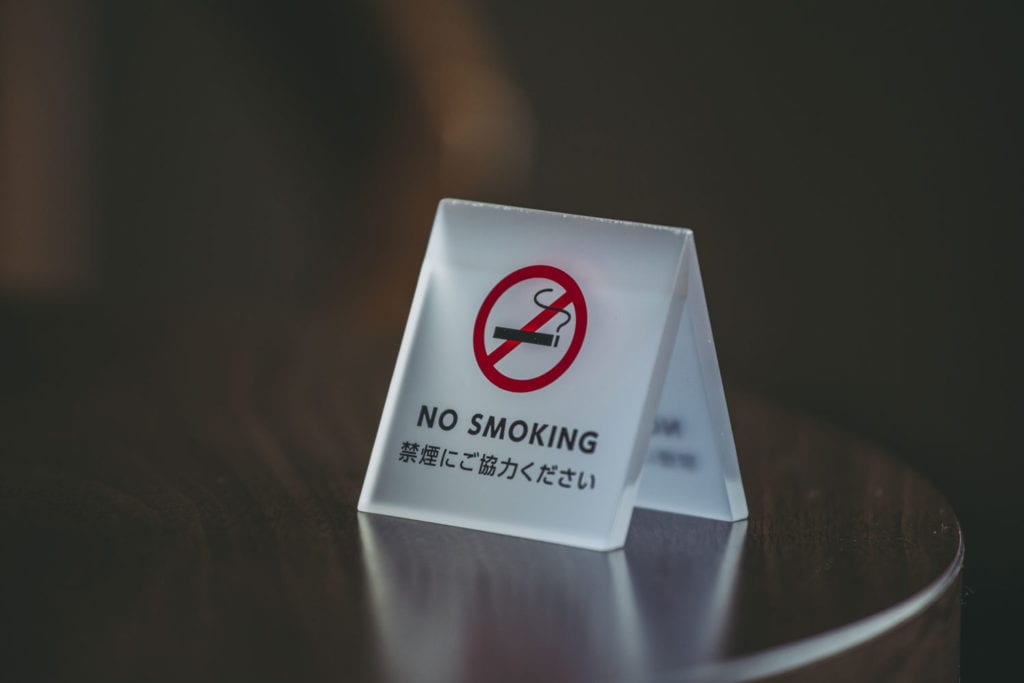A new challenge for tobacco control in Japan: Heating Tobacco
 Jack Olczak, the newly appointed CEO of Philip Morris International (PMI), the largest tobacco company in the U.S., said in an interview with the Nihon Keizai Shimbun, “We will withdraw from the Japanese cigarette market within 10 years and focus on heating tobacco products.” [1]
Jack Olczak, the newly appointed CEO of Philip Morris International (PMI), the largest tobacco company in the U.S., said in an interview with the Nihon Keizai Shimbun, “We will withdraw from the Japanese cigarette market within 10 years and focus on heating tobacco products.” [1]
1. BACKGROUND
In 2016, PMI took the lead in introducing tobacco heaters. Now, more than 70% of the heated tobacco market in Japan is controlled by PMI, which is almost a monopoly. [2]
Japan has banned second-hand smoke from izakaya and coffee shops since the enactment of the revised Health Promotion Law in 2020. However, tobacco heaters such as these, which tobacco manufacturers say do not produce second-hand smoke, are not completely prohibited under the Revised Health Promotion Law, and the Government of Japan allows limited opening. [3]
2.The once Smoke-filled World of Smoking
I asked my father, who had been stationed in Japan in 1996, and he said he was surprised by the smoke-free approach to restaurants and cafes in Japan. It is common to see two rows of tables and chairs, one with a no smoking sign and the other with nothing. There was nothing between the two rows of tables and chairs. That’s it. Those who want to smoke will sit on one side, and those who don’t will sit in the other. And the smoke of second-hand smoke permeates the whole space. This did not change until 2007, when East Japan declared the Shinkansen smoke-free.
This did not change until 2007, when East Japan declared the Shinkansen smoke-free.
Japan will implement the revised Health Promotion Law from April 2020. To prevent the harm of second-hand smoke, smoking will be banned in all places except homes, restaurants and hotel rooms, as well as inside buildings and on public transport.
3.Young people are turning away from alcohol and cigarettes, leaving 20 percent of the population smoking
Back in 1966, more than 80 percent of adult Japanese men smoked. However, according to the latest statistics on tobacco information from the Ministry of Health, Labor and Welfare, less than 20 percent of the population in Japan now have the habit of smoking, and most of them are between the ages of 30 and 60. This is contrary to the stereotype that Japanese people love smoking in the past. [4]
Heated smoke showed a different trend. In just five years, the proportion of adult men and women who smoke hot cigarettes has risen to more than 30 percent. Japan once accounted for nearly 98% of global shipments of heated tobacco. [5]
4.Cigarette is limited, heated cigarette has successfully expanded the market share?
Since the introduction of heated tobacco into Japan in 2016, there has been an ongoing debate over which type of tobacco poses the greatest risk.
General paper cigarettes are made by burning tobacco leaves, allowing the addict to inhale the smoke containing nicotine and other chemicals into the body, causing the contraction of peripheral blood vessels and producing a sense of excitement. Heating tobacco is to use a heater to heat tobacco leaves without burning them, so that nicotine on tobacco leaves becomes a suspended particle into the smoker’s body.
5.Health challenges of heating smoke?
The main reason is that the tobacco industry in Japan is under the jurisdiction of the Ministry of Finance, and tobacco sales must comply with the Tobacco Business Law. The first clause of this law is “for the purpose of the sound development of the tobacco industry and ensuring stable fiscal revenue”. JT, the largest tobacco manufacturer in Japan, spends tens of billions of yen on advertising every year. In addition, Japan is more tolerant of tobacco advertising than other countries. Even electronic cigarettes, which are banned by all countries, are only regulated in Japan: Those that contain nicotine cannot be sold, leaving nicotine-free e-cigarettes in a legal gray area. The lack of regulation and control over the heated tobacco industry, when it has taken off so quickly, has made it easier for young people to be exposed to and attracted to overwhelmingly addictive heated tobacco advertising. At the same time, young people are the biggest beneficiaries and users of online media in the new information age, which in turn will lead to more smokers, especially young people. In conclusion, before heated tobacco products become an uncertain and unpredictable cause of harm and disease, we must take responsibility for a better tomorrow by introducing reasonable and complete production regulations and legal restrictions for young people and all smokers.
Reference
[1] No PMI cigarettes in Japan within 10 years (2021) Tobacco Reporter. Available at: https://tobaccoreporter.com/2021/05/07/pmi-to-stop-selling-cigarettes-in-japan-within-10-years/ (Accessed: November 14, 2022).
[2] Japan Tobacco Inc.. annual report FY2016 (no date). Available at: https://www.jti.com/sites/default/files/global-files/documents/jti-annual-reports/fy-2016-annual-report-fy2016-e-all.pdf (Accessed: November 14, 2022).
[3] Category:legislation of Japan (no date) Wikimedia Commons. Available at: https://commons.wikimedia.org/wiki/Category:Legislation_of_Japan (Accessed: November 14, 2022).
[4] Philip Morris International (2019) Why cigarette sales are substantially declining in Japan, PMI. Philip Morris International. Available at: https://www.pmi.com/smoke-free-life/substantially-declining-cigarette-sales-in-japan (Accessed: November 14, 2022).
[5]Philip Morris International (2022) Association between the introduction of heated tobacco products and declines in cigarette smoking, PMI. Philip Morris International. Available at: https://www.pmi.com/sustainability/case-studies/association-between-introduction-of-heated-tobacco-products-and-decline-in-cigarette-smoking (Accessed: November 14, 2022).




Recent comments